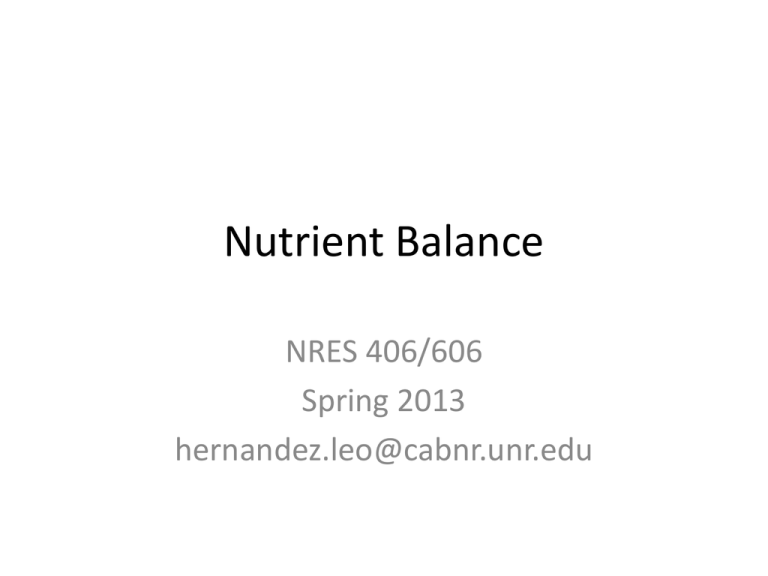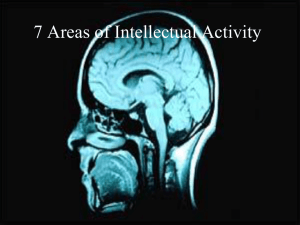March 4 & 6
advertisement

Nutrient Balance NRES 406/606 Spring 2013 hernandez.leo@cabnr.unr.edu The study of how plants absorb and assimilate inorganic compounds is called Mineral Nutrition and it is specially important in agriculture and environmental protection http://www.biology-blog.com/images/blogs/10-2007/fertilizer-15101.gif http://serc.carleton.edu/images/microbelife/topics/map_of_gulf_of_.jpg • Higher plants are autotrophic organisms http://www.sheppardsoftware.com/content/animals/kidscorner/images/fo odchain/fullchain.gif • Higher plants are autotrophic organisms – Synthesize organic components out of the inorganic elements found in their surroundings http://www.sheppardsoftware.com/content/animals/kidscorner/images/fo odchain/fullchain.gif • Most of the nutrients plants need are taken up by the roots directly from the soil solution • Most of the nutrients plants need are taken up by the roots directly from the soil solution http://www.savingwithshellie.com/wp-content/uploads/2011/01/Vitaminwater.jpg CHO • ~85% of plant dry matter is made of – C (Atmosphere) –H –O http://spark.ucar.edu/sites/default/files/images/large_imag e_for_image_content/co2_molecule_720x400.gif http://www.lenntech.com/images/Water%20molecule.jpg What are those inorganic elements? • Are all these elements equally important for plants? What are those inorganic elements? What are those inorganic elements? Essential Elements Essential elements • Those that have a clear physiological role. • If plants receive all of these plus water and sunlight they will synthesize all the compounds needed. • Based on the relative abundance in the plant… • Macronutrients – >1% – N,K, Ca, P,S, Mg • Micronutrients (Trace elements) – <1% http://www.stewardcoaching.com/wordpress/wpcontent/uploads/2012/01/quality_vs_quantity.jpg • Nutrient concentration is not constant among different plant structures. Why leaves? • Nutrient concentrations in the soils ultimately determine the acquisition and concentration in plants. • Some soils have high concentration of specific elements, like heavy metals. – Au, Ag, Ni, Al Hg Accumulator plant In some cases, plants growing in soils with high concentration of a particular element can accumulate large concentration of that element without apparent side effects. Equisetum • The atmosphere is the mayor source of N – Biotic dinitrogen fixation – Deposition • Some cations may come from particulates traveling form other regions or from industrial pollution – Na (sea salt in coastal regions) – Fe & P from Africa Nature • Nutrient recycling is the major source of soluble nutrients http://polaris.umuc.edu/~meaton/edtc620/omed/images/decomposit ion.jpg • Nutrient recycling is the major source of soluble nutrients Microbial Activity http://polaris.umuc.edu/~meaton/edtc620/omed/images/decomposit ion.jpg 1 2 3 4 2. How the element is found in the soil 4. For that plants take up the element 8. Within the plant 5 6 7 8 3. How does it change from 2 to 4 5. How does the element exist w/in the plant 1 2 3 4 5 6 7 8 • Most of N in soil is found organically bound • Microbial activity is required to make it available fro plants • Element that plants need the most • N deficiency rapidly affects plant growth • chlorosis http://hort.ufl.edu/database/images/nutdef/thy9529_M.jpg P • Integral component of plant cell • Used in energy metabolism • Stunt growth and yellow foliage S • S and N are constituents of many proteins. • Deficiency symptoms are very similar to those of N. http://pics.davesgarden.com/pics/2008/12/20/dar ius/c498d5.jpg K • Inorganic form • Found as free cation in plants (Osmotic potential) • Activates many enzymes involved in photosynthesis http://www.ipni.net/ppiweb/gseasia.nsf/$webindex/914E7F33D86 6E03848256E8900362252/$file/%23601%20legume%20lcp%20k% 20def.jpg http://upload.wikimedia.org/wikipedia/comm ons/thumb/5/57/Chlorophyll_c2.svg/220pxChlorophyll_c2.svg.png Mg • Enzyme activation • Synthesis of DNA and RNA • Deficiency causes intervein chlorosis Ca • Synthesis of cell wall • Cell Division (mitotic spindle) http://www.enst.umd.edu/files /PicsWeil/MagnesiumPoinsetti aRRW.jpg http://upload.wikimedia.org/wikipedia/commons/thumb/2/2e/Blosso m_end_rot.JPG/220px-Blossom_end_rot.JPG Fe • Component of enzymes involved in e- transport • Intervenous chlorosis http://cleatordesigns.files.wordpress.com/2 011/03/032409-hartman-rhodo-fedeficiency-kaiser-h17-73.jpg Why a chelate? http://www.drt.com.tr/doctoferro/images/chelate.jpg All micronutrients are found as inorganic compounds in the soil http://middletownhighschool.wikispaces.com/file/view/plantcell450.jpg/98794271/plantcell450.jpg • N, P. S, Fe and Mg are directly involved in metabolic activities • Ca and K are inorganic ions but are biological active ( osmotic potential) • Leaves are the most common place of nutrient accumulation within plants (vacuole) • Except Cl, all other micronutrients are stored as organic forms Nutrient Uptake 1. Dissolved nutrients are taking in with water due to the continuous movement of water driven by transpiration SPAC Nutrient Uptake 2.Proton pump: H+ excreted out of cells affect the absorptivity of ions in the soil and release them into the soil solution. By releasing H+ and HCO3- from the roots, plants promote ion exchange at the surface of clay particles. (Root Exudates) http://extension.missouri.edu/explore/images/mg0004art04.jpg Nutrient Uptake 3. Weathering of the soil: Roots can release compounds that lower the pH breaking down soil particulates. http://www.drt.com.tr/doctoferro/image s/chelate.jpg http://it.pinellas.k12.fl.us/Teachers/madeirosa/images/48655D05E7824170A64E008894255590.gif Nutrient Balance Episode II Nutrient uptake – Passive • Following a gradient – Active • Against a gradient http://www.funtasti.com/pdata/t/l-31.jpg Ion Uptake into the cell • Passive transport – Transport proteins • Channels – (Selective) pores – Size and Density • Carriers * – Substance being transported binds to the carrier – Conformational change – Dissociation Ion Uptake into the cell • Active transport – Energy depends on photosynthesis and respiration – ATP-ases function as proton pumps • Electrochemical gradient – Present in plasmalemma and the tonoplast Proton Pump http://avonapbio.pbworks.com/f/electrogenic.jpg H+ Pump Electrochemical gradient Uniports Cotransporters Uniports: •Integral proteins •Charge Specific •In the tonoplast these could be ionspecific. •Low affinity Cotransporters: •Integral proteins •Active transport •Require H+ pump •High affinity •One way & Two ways Cotransporters Response to Nutrient Supply • Michaelis-Menten • Uptake increase in response to supply until a maximum value is achieved (Imax) • Km: nutrient concentration at which • Imax/2 is reached http://depts.washington.edu/wmatkins/kinetics/mm1.gif Km as a measure of Affinity • Km is a measure of the capacity of the root to use nutrient at low concentrations. • Km Affinity • Km Affinity L.A.S H.A.S H.A.S L.A.S






